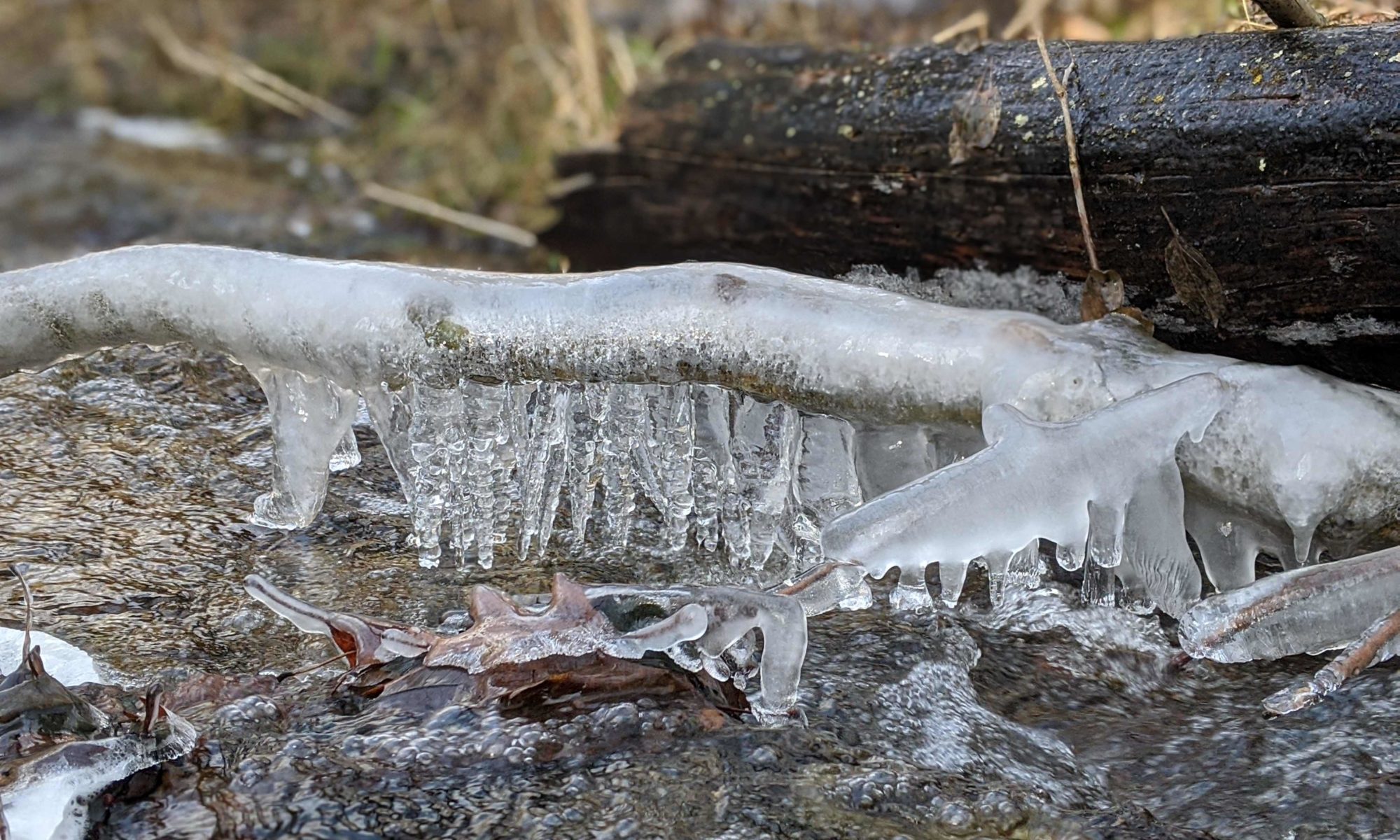The winter cracks our perception of ourselves. The seasons toss us through cycles of wash, rinse, dry, and tumble; every year we get the same treatment even though we sense each stage in a cycle of unique moments. Nature signals familiar patterns if we look, but many of us now live a life of screens: going from big screen (TV) to little screen (phone or tablet), from bad screen (work) to good screen (home). We are looking at life as an apparition.


The signs of winter are curious and unique: splits, cracks, animal tracks, fractals, obstacles.



When there’s a fresh snow you can tell what went before you. Water shape shifts from thundersnow to ice floes to thick platforms. Blocks of ice stagnate.



Crystalline patterns of water in various states form on our windows and along our daily routes. Objects become frozen in time.



The Physics major inside me finds a lot to love. The way fresh snowfall perks up all it coats in a gentle blanket; the way moving water freezes mid-float down a river’s fall; the way intricate weather conditions conspire to coat the world in dangerous but glistening magic princess ice. The way objects poke up cutely through their white blanket.



Nature has frozen in time; space floats while time stops. My mind is numb as though all its contents have frozen mid-drip into the void. The patterns of ice intrigue me; why do they freeze in the different ways they do?


Winter affords us a different view of familiar objects. Snow nestles into the comfort of acorn shells. A sewer gate looks practically artistic. Nature’s leftovers are decorated in white lace. No other time of year can you tell where people or animals have gone as well as you can in winter.



Sometimes, snow simply gets in the way of life: Where there was space, now there’s snow. Everything left outside gets the snow treatment here. Its winter appearance is different than its non-winter appearance. Those who live in warmer parts of the world don’t experience this dichotomy.


Growing up in California, we used to just “go to the snow.” It took me over 10 years of living in Wisconsin to understand the non-optional cold and associated dress code and much longer to embrace it.
In early 2022, I took my first interstate COVID-19 era trip and had the luxury of choosing to “go to” the snow. A strange destination for someone looking to escape winter in Wisconsin, but it’s all about choice.



Disposing of your mattress is different in winter. We try to get around but it’s a lot harder. There is no swimming and no roller coaster ride. It becomes more and more difficult to move.
I love to read about the Arctic, but only in winter. You name the book or expedition, I’ve read it (My favorite: Ada BlackJack: A True Story of Survival in the Arctic. Runner up: Arctic Village: A 1930’s Portrait of Wiseman, Alaska). Why? Perhaps it’s the drama. Isn’t that why we watch crime shows and soap operas? More than that, I gain insight into how people who live in perpetual winter understand and engage with this season year round. As a summer person at heart, it helps me appreciate winter. I like learning how people cope with living in extreme conditions.


Promotional photo from the Timberline Lodge, OR, which served as the exterior of The Overlook Hotel in The Shining, another favorite book of mine about people going crazy in winter.

Each season coaxes a different language and personality out of me. Winter person longs for life and evidence of living; summer person is drowned in it and looking for reprieve. Winter person spends a lot of time in her head. Summer person is out of her head. Spring and fall mediate these two extremes. Spring is holy; fall is relief.
The color palette of winter curbs summer’s enthusiasm: shades of brown and beige contrast with white on a backdrop of dead, muted green. Different languages have different words for colors; languages of people living intimately with nature with little exposure to artificial colors, like ancient Greeks or Papua New Guineans, often lack words for colors like blue or purple (according to Through the Language Glass: Why the World Looks Different in Other Languages). Our eyesight adjusts to what we see on a regular basis: our world can limit our understanding of color and decision to differentiate between different hues.


Winter person’s vision has become accustomed to a palette of muted grays, browns, dirty whites, and the occasional red dogwood twig, sumac inflorescence, or burst of still-surviving green.


Winter brings into focus many things that go unnoticed in summer abundance: moss, lichen, the tentative and timid sprouts or super hardy greens that survive even under ice.



Lichen: Primordial plant blobs, a synthesis of organisms crawling less than an inch in a decade. If lichen grows that slow, does that make it OK for me to slow down? What does an inch of lichen growth see? What do I see in in comparison?


Moss and cones: Winter gives treats to direct our focus if we choose to discover its hidden worlds. The things we miss when life is abundant. The things we miss when life is scarce.


As spring approaches, the sunlight starts peering through our eyelids, waking us up out of our winter slumber. Happy signs abound.
Crisp, icey breath
My mind is playing tricks on me
While Mother Nature watches from afar
On frozen grass.
Ice crystals, cold brisk clean feeling air, snow crunch. You’ll miss winter when it’s gone.


